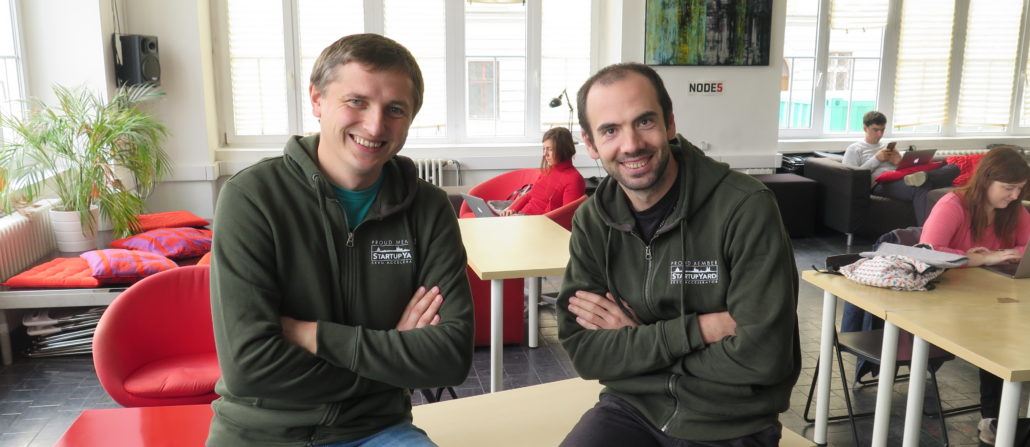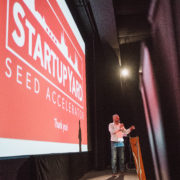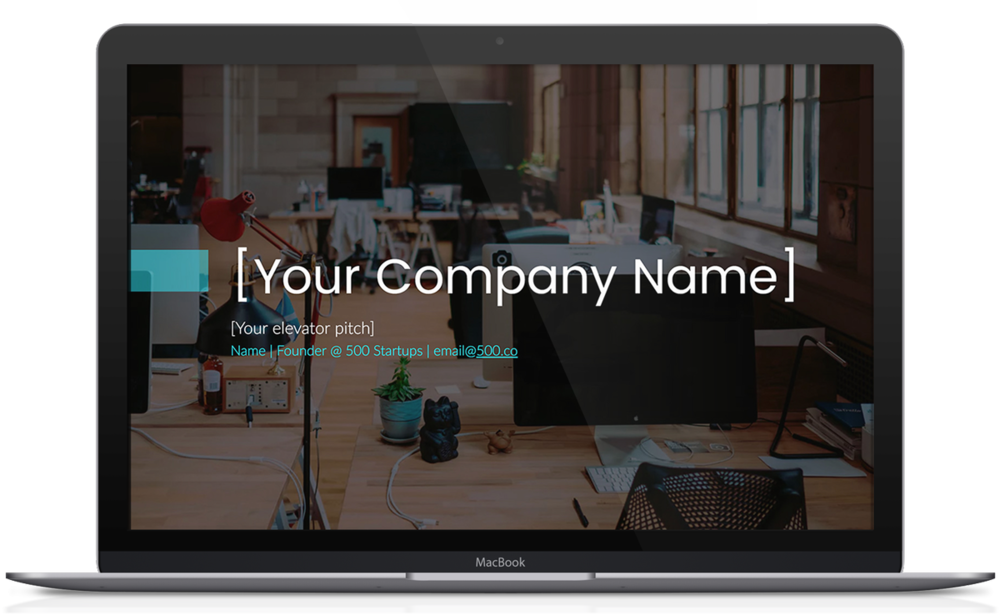Is The Startup Pitch Session Dead?
/in Starting a Business/by StartupYardAs the most recent startup conference season has gotten rolling, I’ve been on the road to different cities in the CEE region. Warsaw, Kiev, Budapest, and soon Gdansk and Vilnius among others.
Certainly there are more startup conferences than there ever were in the past, so we’ve become increasingly choosy about which ones we attend. Today to evaluate a conference opportunity, we ask first “will they let us speak and present StartupYard,” and second “will we get 1 to 1 time with startup founders?”
The Best Startup Conferences Aren’t Tradeshows Anymore
I must say this is somewhat a reversal from the days when I first attended tech conferences. It used to be all about the pitch sessions. The whole event would be organized around a few keynotes at different stages, and a series of pitches, often with a big prize to draw startups and a crowd. That is the experience at places like Slush and Disrupt, as well as the former LeWeb.
We’ve written before about how useless this carnival approach can be for many who try to make real connections and tangible progress at such events. The light show outshines the personal connections, unless you are the type of person who can work a room full of strangers like a pro networker. You’re probably not. Natural social butterflies are rare in this business.
The most shiney startups would pitch, and then I assume they’d be bombarded with interest from investors who compete for their attention, rather than the other way around. This system had its obvious problems, but the worst was that it gave many startups the impression that they were shopping for the best offer from investors, rather than looking for a real match with the right investor.
My personal disgust with this dynamic culminated with an investor keynote in which a particular VC, who will go unnamed, patronizingly explained to startups that they need to “be the hot chick at the party,” for investors, and “play hard to get,” and assorted other bogus mind games that make founders impossible to deal with. Sexist and gross, of course, but also counterproductive and boring.
Obviously this is self serving, but StartupYard simply does not compete on the size of our investments, and we don’t want to talk to the “hot chick,” we want to find the company with the best team who want to make a real global impact. For a long time that kind of investor and startup attitude made conferences less than effective in helping us to scout and make relationships with startups that could fit well into our program.
The Pitch is Dead: The Conversation is Back
So I say with some relief and hope for the future, that it does appear that the up and coming startup focused events around CEE, the ones not burdened with heavy price tags and expensive catering, are doing away largely with the pitch competition format. Big ticket events focused on the public, corporate executives, and big speakers are still around, but happily startups are gravitating to more personal events where they can have time to really talk to people.
At Wolves Summit in Warsaw just last week, there was a pitch stage, but there were only around 50 seats, and I didn’t attend a single pitch session.
I was too busy taking great meetings with relevant startups, arranged in advance with intuitive software, and held in 4 different halls with a stunning 120 tables in total; most of them occupied. Interestingly too, at Wolves there is effectively no main stage, and consequently no temptation by the organizers to book big headlining speakers– a decision that inevitably leads to higher prices, more tech/startup tourists, and less time for startups to meet with each other and with investors.
When Wolves got started in Warsaw, the event was a pitching event. It was held in 4 screening rooms, and mentors were in fact pitching judges. As a result, very little personal interaction could happen because people were too busy with the pitching. The event has steadily improved with the focus on personal interaction.
Conferences that have built their reputations on speakers who charge €25,000 or more to talk about their salad days at Apple, or as VC investors, early Google employees, or startup founders, have becoming increasingly irrelevant for early stage, truly disruptive young companies that don’t have a splashy B2C concept and a great marketing gimmick. That’s ok. There is a place for more entertaining or corporate driven conferences with more flash, but for early startups, today there are much better options.
As the startup ecosystem in CEE gets more high-tech and less flashy and B2C, personal interaction is more important than ever.
At conferences like Wolves or Startup Fair Lithuania, speakers are unpaid volunteers, meaning only those with a strong urge to share their stories and a good reason to do so are speaking to smaller groups who are attracted by more than just a name or someone’s impressive resume.
That’s good news as far as I’m concerned, because it means that increasingly conference organizers and startups are understanding what is really key about these events: becoming a place where the relevant parties can make connections with each other. Today you see fewer startups sending their head of marketing or sales to conferences, and more likely you see the CEO and CTO there themselves. Even companies that are later stage seem to be doing this more.
Are Pitches Still Relevant?
Very much so. But not in the way they used to be. Not only conferences, but also accelerators and incubators have been recently questioning the pitch format for Demo Days as well. The key criticisms are exactly the same as for conferences, which is why at StartupYard we’ve continued to evolve the format to bring the greatest value to investors, community members, and startups.
We still strongly believe that preparing a killer pitch is a very important discipline for a young company and a first-time founder to master well. It forces founders out of their personal bubble, and defining the content of a pitch demands that startups make tough and necessary decisions, while striving to achieve things quickly that can become part of their story. All that is good and very much needed.
At the same though, much else has changed. For example, the stage portions of our Demo Days are now shorter than they were before. We’ve reduced keynotes significantly from the past (they used to take an hour or more), and we focus on holding the Demo Days in spaces where our startups can have meaningful contact with attendees after the pitch, and for much longer, up from maybe an hour in the past to multiple hours of 1 to 1 and group conversations. Demo Days are becoming more interactive as time goes on, and I see this happening in other accelerators as well.
We also introduced an official “Investor Week” a few years ago, and that has grown very popular. Investors who attend the Demo Day can now book a meeting with any of our startups in the following week, eliminating the fear that they won’t get in any facetime with the companies they want to meet.
Pitches are still relevant. But today’s connected world means that content is easy to share and to find. Personal contact, face to face, is more valuable as a result. By all means, work on your pitch, do your pitch, share your pitch, but don’t forget what a pitch should lead to: a real conversation.
The Sales Trainer’s New Best Friend: MindBoxVR Reveals Open Beta
/in Startups, StartupYard News/by StartupYardSales Trainers know the value of real world experience. But how can they provide it to large groups of trainees in a limited time? Mindbox VR, a StartupYard Alum, has the solution, and any sales trainer can use it today. Peter Tomasovic, CEO and Co-Founder of Mindbox VR, is a StartupYard alum from Batch 8, focusing on a VR solution for sales and customer service training. Mindbox started out as a tool to help mental health professionals treat the symptoms of phobias, such as a fear of heights, or of insects, using VR simulations as a form of immersion therapy.
During the StartupYard program, the Mindbox team hit upon sales training as a novel use for their VR technology, which allows non-programmers to quickly and easily create scenarios for sales and customer service training sessions. The biggest advantage of using VR for these purposes is that it simulates a real-life experience, and can also be used to generate statistical data that sales trainers can work with to improve the performance of trainees with time. Plus, MindboxVR can be used to train many people at once, and even after the training for skill reinforcement.
You can check out MindBox’s open beta now by clicking here.
I talked with Peter this week to find out how MindBox got to where they are.
What have been your biggest challenges since the StartupYard program? How have you solved these?
Our biggest challenge has really been to find out what our customers really need from Mindbox. Separating the “nice to have,” from essential is super important to be able to deliver something that works on the first try. Our customers don’t always know exactly what will be the most necessary features, because most have never used this technology before, so it’s a process of discovery for all of us.
When we were at StartupYard, lots of companies wanted to work with us on the process of validation and experimentation, but in the end they want to have a useful delivered product, so you have to get it right.

Slovak entrepreneurs Peter Tomasovic (right), and Andrej Rybovic (left), Co-founders of Mindbox VR.
Another challenge was to hire new people versus do-it-yourself. When we counted costs for new people, onboarding, learning them technology, understanding product specification, we decided to develop the first version ourselves and use external experts only when solving specific problems or for feedback. This allowed us to move more quickly short term, but it will be a challenge then to scale up the team and delegate when demand is increasing.
How did you arrive at the set of features you have now, and what do you plan for the next iteration?
For the current set of features, two sources of information were most important:
- companies and training agencies (customers)
- our advisors
In the case of potential customers, the Pareto principle worked for us. We met with lot of companies, 80% of them gave us “standard feedback” and lot of brainstorming, which was mostly distracting. The other 20% gave us what we have now – a set of features, idea of the scenarios that could be interesting, company use cases. And what is important, is that we are still in touch with these companies and they are now strategic partners.
It is a learning process to understand which prospects are going to be your real customer, and which are going to distract from the development process. We are still learning this.
Our advisors gave us key support here. During StartupYard we met 3 great people, Serge Dupaux, Jana Zurkova, and Silvia Pánková – experts in the fields of HR, business development and sales. We have regular meetings, we had a one day workshop, where we defined a customer journey with the key product features, etc.
For the roadmap and next iterations, we have a set of features from meetings with companies or analysis of competition. But most important for us is to make pilot implementations and find out which features are really crucial. That is the reason we are right now focusing on selling and looking for partners.
What kind of people can most benefit from MindBox VR?
MindBox VR is like a swiss knife for every sales trainer in customer service, product training and sales training.
Unlike most training solutions, MindBox VR is about interaction and immersion. It allows a trainee to interact with voice and reply to a virtual customer. The physical act of doing the interactions repeatedly is many times more effective than just listening to a speaker or reading about the techniques.
Once a training program is created by a sales trainer in Mindbox VR, it can be started on any Android device, but also in a VR headset. Currently we are supporting mobile VR headsets like Gear VR or Google Daydream. This makes it really easy for a sales trainer to deliver their program with whatever equipment they or their clients can afford.

If you want to train customer service, you can prepare a training where virtual customer asks you typical questions. They can be standard, like questions about warranty, transport, returning product. Or the can be more “tricky”, like “This product is very cheap. Isn´t it a fake?”. The trainee has to reply to such questions. The mix of standard and non-scripted interactions helps employees to internalize the company policies and best practices, and to be more comfortable in unexpected situations.
So why should a sales trainer use VR instead of more traditional methods?
The key is repeatability and a systematic approach. We all “know” how we would act in some hypothetical situation. But in actual truth, we don’t really. When you are in a real life scenario, there are a million complicating factors to consider, so having the learned experience is the best way to help people be prepared. However, simulations using real people are often less realistic. Co-workers know each other and are often friends. Co-workers want to help each other, naturally.
When you do play-acting in sales training, the situation is never the same for each participant. It might work for some, but not for all. VR allows us to replicate a specific situation very precisely, and apply systematic testing and feedback on performance. The human approach is still critical, as we are talking about soft human skills, but VR can support this with a data driven approach on top. We don’t want to replace trainers or in-person training, but to augment it with easy-to-use software tools.
Moreover, sales trainers can set keywords in conversation – critical words that must be said by the trainee when replying. Practice makes perfect, is the saying. Most important about training with MindBox, is that the trainee has to speak, and really answer questions. It’s not just a dumb script, but a simulation that feels real, and that can change according to what the sales trainer plans.
This way, you are not developing only knowledge (like when he is reading or watching a slideshow) but also skill, because you have to think about the information in a sentence and actually come up with the right answer for that specific situation.
After the training, trainers will see statistics, reports and complete transcripts of communications with customers, so they can deeply understand what is working, and what needs more work.
Are you looking for funding or more partners? Who should contact you?
We are in touch with some VCs and investors, but for them it’s most relevant to have traction and signed contracts with customers. That’s especially true because this technology is so new to the market, and the market has to be proven.
Therefore most important for us right now is to acquire more early customers and partners who want to really improve their training processes and be among the best in the industry. We have an open beta version, and sales trainers can start training from day one.
We also have 2 example trainings, which a trainer can easily adjust for company needs and start training quickly to see the results. The most relevant first contacts are HR people responsible for corporate training, learning and development, as well as independent professional sales and customer service sales trainers. Heads of sales and those in charge of personal development programs will also find a lot of value in what is available today.
StartupYard is Looking for Founders!
Are you a startup founder ready to accelerate your business with CEE’s best network of top mentors? StartupYard’s Batch X Open Call has started.
Our focus this round will be on Automation, Blockchain, and the Future of Work. If you’re working on a hard problem involving Machine Learning, IoT, Identity, Payments, Security, or Decentralization, then we want to hear from you. Find out if StartupYard is your key to a big future.
Peter Cowley: How to Talk to Angels
/in Startup Tools/by StartupYardRecently I got an email from my friend Peter Cowley, director of the UK Business Angel Association and the Cambridge Angels. Peter has been in tech for nearly 40 years, starting over 10 companies. In 2014-15 he was named UK Angel of the year for his investments in early stage companies. So when he writes down advice about angel investing in his newsletter from the Invested Investor, I pay attention.
Back To the Email. It’s clear Peter had had one too many poorly executed sales pitches lobbed his way that week (he was about to go on holiday he told me later), so he sat down to sketch out some ground rules that startup founders should seriously consider following. I’ll post them below with my comments. Any bolding is mine.
Don’t Call Me, I’ll Call You: No Cold Intros
Advice to entrepreneurs – do you like being called up by a passionate salesperson on your personal phone? If yes, you’re lying. It is a no. I am not saying that you shouldn’t approach angels, otherwise we wouldn’t be able to help you, but I want to give some of my own views on how best to approach us, or at least me!
It is always better to receive a warm introduction than a cold one. This can be through another entrepreneur, another angel or even friends or family. An angel group is a great way to find angels. Have a look for deal ‘sorcerers’ or gatekeepers for the angel group from which you’re seeking funding.
Cold introductions can be extremely annoying. Phone calls definitely don’t work for me, LinkedIn is nearly as bad, direct emails to me will be deleted, unless you fit in with my criteria and have followed the instructions on my website. Cold emails can be sent to angel group gatekeepers. Attempts have been made through social media, but they rarely work.If you can’t leverage your own network to reach the right person, then look at that person’s own network and work from there. There’s nothing worse than getting a cold email from someone who didn’t need to do it that way.
Paradoxically, strangers will always be more willing to help you connect with someone else, than they will be to help you directly. You might call this the “someone else’s problem,” effect. You can use this to get your message to the right person by giving someone else in their network a chance to feel or seem useful and informed, ie: “Dear x, I’m writing you for advice because of your deep connections with StartupYard…”
Use the GateKeepers
Accelerators and incubators are a great way to build connections. Many angel groups and some angels are known by accelerators and incubators, so joining one will ensure warm introductions. Accelerators and incubators offer advice and mentoring and it is positive that you’ve gone looking for that already.Angel group gatekeepers are the main way into the group. You can usually go cold through a group website, and this may work for some groups, but I like to see the entrepreneurs seeking out the gatekeeper first (becauseor better seeking out an angel).
First impressions are paramount to the relationship, so make sure you are approaching the right person. I list my investment criteria on my website, and I know the vast majority of angels don’t, but this will help save time for entrepreneurs and angels. As an entrepreneur, don’t be too pushy but do show the boldness to approach me with something, that will interest me.
This may sound like a lot to think about, particularly when you have such an incredible idea. But, angels hear from so many entrepreneurs. Save yourself time and effort, as well as ours, by doing thorough research before any approach.
This cannot be emphasized enough. We have it as a mantra that “You are Only Ever One Email from a Major Breakthrough.” That does not mean you should send 1000 emails today before lunch. It means that the right email, at just the right time, can make all the difference.
It’s a continuing shock to me how few startup founders bother to do basic research. And I don’t mean googling us and finding out we’re an accelerator. I mean reading what we’ve written, looking into our network, finding common connections, and even coming up with questions you want us to answer about ourselves.
I can tell you I’m maybe 10x more likely to answer an email from someone if the email contains a thoughtful question or two. That could be about our program or about something else relevant to what we are interested in and what we talk about publically. Engagement feeds engagement. Once you start talking with someone, they come to see you as a person, not just an email notification.
Yet few founders (other than our own alumni, who are wiser) use StartupYard as the gatekeeper we are. It’s as if we’ve left a rolodex on the table full of choice contacts that startups desperately need, and they’re just walking right past it.
The best are where the entrepreneurs have researched the members of an angel group (not all members are public) and then approached one, asked for help, listened, and then that angel introduces the startup to others. The simplicity of this approach misses many founders. Instead of compiling a list of targets and sending them all a call to action, or what we might call “the numbers game,” a wiser founder bites around the edges of a network looking for a way in. The key here is to establish one contact at a time and actually listen to what they have to say, and act on it. If you were to email-blast a whole list of people at once, you’d then have burned your bridges if one of those people suggested introducing you to one of the others. Instead of “oh hey this startup seems interesting for you,” it’s “oh, yeah I got the same spam as you did.”
Be Bold… But Follow the Rules
In a follow-up email, Peter wrote this, which I think is worth highlighting: One of the advantages of my published criteria is that many opportunities never get to me, and when they arrive by email, several answer my criteria, or point out which criteria they don’t meet.The worst examples are people approaching me after an event where I have spoken (and where my name is on the programme), having done zero Due Diligence on me and then wasting my (and their) time when there are others waiting to speak to me. I’m sure my firm rejection must seem rude to some.Peter mentions this page which contains detailed criteria on investments he is interested in. What is important to note here is that he makes clear he welcomes contacts from people who do not meet the criteria. The important point is whether or not a startup knows they meet the criteria or not. We have much the same attitude. When a founder emails StartupYard aware that some aspect of their business puts them outside our immediate scope, then we can at least have a conversation about how we can help them despite this fact. If instead the founder simply reaches out without acknowledging this problem, our immediate response to just say no. The person isn’t paying attention to begin with. If the investor has to start out their reply by saying: “we can’t move forward because of X,” then you’ve guaranteed yourself a no. On the other hand, if you’ve covered that objection already, then the investor must at least think a bit more deeply about the opportunity. They can still say no, but acknowledging how you do or don’t fit into someone’s criteria can turn a hard no into a soft one. Maybe you don’t meet the criteria right now, or maybe the criteria aren’t as relevant in your case. You can’t have that discussion if you don’t know what they are to begin with. More About Peter Cowley
Peter Cowley, a Cambridge university technology graduate, founded and ran over 10 businesses in technology and property over the last 35+ years. He has built up a portfolio of over 60 angel investments with 3 good exits and several failures. He is the WBAF Best Angel Investor of the World and was UK Angel of the Year 2014/15. He has mentored hundreds of entrepreneurs and is on the board of eight startups. In 2011, he founded and has since run Martlet: a Corporate Angel, investing (currently £5+M) from the balance sheet of Marshall, a £2bn revenue Cambridge engineering company. He is chair of the Cambridge Angels and is a fellow in Entrepreneurship at the Judge Management School in Cambridge. He is a non-executive director of the UK Business Angel Association and on the investment committee of the UK Angel Co-fund. He has also had 16 years’ experience as chair, treasurer and trustee of the boards of seven charities and is voluntary equity finance chair for the Federation of Small Businesses. He is sharing his and others’ experience and anecdotes of angel investing by publishing online and offline – see www.investedinvestor.com
The Worst Term Sheet We’ve Ever Seen
/in Startup Tools/by StartupYardLast week we talked about what makes a startup investor “Founder Friendly.” While that’s important to know, it won’t help startups much if they aren’t aware of what the opposite case looks like: when is a term sheet definitively unfriendly to founders?
With this in mind, we polled a collection of investors and lawyers who are friends of StartupYard, and they shared examples with us of the worst term sheets they’ve ever seen, and what was wrong with them. This post should serve as a handy guide to avoiding the worst terms out there.
Too Much Too Early
Several of the respondents noted problems with a company’s early stage valuation, along with protections for both founders and early investors, as a key problem in later rounds.

Chris Kobyletcki, Innovation Nest
“I think it can go both ways. We see investors not taking into account founders for the later-stage investments. Investors take 30-40% of the company at a super-low price that will not leave space for someone new to join the cap table.
The other case is having a super high pre-money valuation that will result in a company not being able to reach the next level of valuation for the next fundraising. I saw multiple cases of rounds falling apart because of that. “ – Chris Kobylecki, VC, InnovationNest

Tytus Cytowski, Cytowski & Partners
“At the Angel Round stage, I have seen CEE angels ask for and receive a board seat, pro rata rights, drag along and protective provisions, which are typical for the series A stage. In general angel should only receive equity without any special rights unless they provide significant assistance to the startup. I have also seen CEE angels and VC investors take up 20-25% of the cap table in exchange for €200K at this stage.” – Tytus Cytowski, Cytowski & Partners

Peter Cowley, Angel Investor
“At the very early stage (ie seed, seed+, A-) sophisticated angels in the UK always offer ordinary shares that are identical to the founders, with no prefs, and no special rights attached to the shares. We do however drag/tag along, pre-emption and other rights and a number of consent rights – see my own term sheet, that I use as the basis of negotiation with founders. This is more a checklist with my suggestions of how the legals should be worded and I am 100% wedded to little of this.” – Peter Cowley, Angel Investor
Cap Table Headaches
Another hot-button issue is the cap table, where founders and investors make mistakes that cause them future problems.

Jaroslav Trojan Equus Ventures
“The most usual scenario is that investors take majority ownership thinking they can ‘control’ the startup. Most of the problems relate to cap table I would say. Also, too many conditional investment tranches are quite a frequent mistake. I also occasionally hear that startups and investors don’t use term sheets at all which may lead to poorly managed round, confusion, and increased legal costs.” – Jaroslav Trojan, Equus Ventures
“One [item I insist on] that strongly surprises founders is reverse vesting, until I have explained to the founders that if one of the founders leaves the business (I have had to negotiate this three times) then their unvested shares are then available to strengthen whatever senior hires are needed to replace the founder If those shares are not used, then the remaining founder owns a bigger share of the pie.” – Peter Cowley
Planning Your Exit
A theme that also emerged in the responses was that founders and investors often fail to plan for the eventuality of an exit, and prepare themselves legally and practically for the eventual sale or liquidation of the investment.
Investors can and do take advantage of the smaller legal resources and lesser experience of startup founders.
“In later stage investments, the big one to watch is (participating or not) liquidation prefs, which if everything goes well, will appear toothless, but if something goes wrong… I was not an investor but there is a 10 figure exit in Cambridge where the founder (having been on the journey for a decade) was squashed to zero by the prefs.” – Peter Cowley
“In a Polish seed VC deal, I saw participating liquidation preferences set at X 2.5 with the preference participating again after payment to founders from the exit. In another deal led by a Polish VC I saw a VC insert a participating liquidation preference while the term sheet called for a non-participating liquidation. In investment agreements I have also seen liquidated damages if founder stops working at the company and/or decides to leave the board of the company. Liquidated damages started at €50K and went upto the size of the round. Standard terms like drag and tag along are often drafted excessively in favor of VC investor.” – Tytus Cytowski
Some less-than-friendly investors can get extremely creative in the ways they ensure they profit most from a startup’s success. As in the above examples, what can appear to be fair on paper can end up costing a founder any chance of profiting from their own work.
To provide some context, a liquidation preference is a clause in an investment contract which ensures that a certain investor receives the profits from any sale of the company first, up to a certain multiple of the original investment. This means that not only does an investor get their share of the company when it is sold, but they may also get more than their original share if the company is sold for less than expected.
For example, if a VC invests €1m at a €4m pre-money valuation, their stake is 20% of the company post-money (€1m out of €5m). If there is a liquidation preference set at 3x, that means that the investor expects to be paid back at least €3m no matter how much the company eventually sells for. If the company sells for €3m, then the VC would take the whole amount, and the founders would have nothing, even though they’d built a company worth €3m.
Often these issues arise because the founders believe that their companies will be worth much more at exit than ends up being the case. A high liquidation preference is not important if the company is worth even more than the multiple of the preference. But if the company sells for less than expected, the investors can take a huge piece (or all) of the proceeds.
Business Culture: Legal Fatigue
One of our own favorite startup lawyers Tytus Cytowski, who has supported our alum Gjirafa Inc. in fundraising, pointed to our regional business culture as an issue:
“Three big picture problems that translate into specific terms. First, CEE investors focus on maximizing control instead of focusing on wealth maximization. The focus on control maximization is a CEE cultural issue caused by lack of trust in entrepreneurs, corporate mentality of investors and the fact that the main LP of the majority of CEE funds is the government.
Silicon Valley on the other hand focuses mainly on wealth maximization and invests with a ‘spray and pray’ mentality. Silicon Valley investors are interested in absolute returns in portfolio, while CEE investors look at returns on the level of each company. The control maximization problem is especially problematic in deals with Polish VCs.
Second, most of the CEE investors have a strong private equity/investment banking background, which does not work well in the startup world. For example, PE/Investment banking is focused on generating fees and strictly growth metrics. Good VCs invest with an understanding of technology, disruption and innovation, not only growth metrics.
Finally, a lot of CEE investors don’t have experience as entrepreneurs and don’t understand the life cycle of a startup and what terms are crucial at each stage. Paradoxically CEE entrepreneurs that become VCs tend to have the most unfriendly startup terms from my experience. In general CEE term sheets are heavy on protective provisions (veto rights), liquidated damages and penalties for founders, drag and tag along, disproportionate equity to risk ratio of startup in favor of investor (above 10 % per round), low valuations. Exception are term sheets from Credo, Reflex and Rockaway, which follow Silicon Valley best practices.” – Tytus Cytowski
That sentiment was strongly echoed by Tudor Stanciu, a startup lawyer and advisor from Romania and former organizer of the HowToWeb conference, who wrote:
 “I think the biggest problem in term sheets is a general one, especially when dealing with corporate VCs / investment arms: the density of language being used. You see 20+ pages of term sheets/SHAs out of which most refer to standard limitation of liability/disclosures that arise from other types of transactions that the VC’s lawyers have done.
“I think the biggest problem in term sheets is a general one, especially when dealing with corporate VCs / investment arms: the density of language being used. You see 20+ pages of term sheets/SHAs out of which most refer to standard limitation of liability/disclosures that arise from other types of transactions that the VC’s lawyers have done.
At least for early stage, pre-revenue startups, founders do not have the ability to reach out to lawyers and pay out fees to get a language-dense SHA cross-checked and simplified by a founder-friendly lawyer, and that can make a founder end up suffering from “contract fatigue” and missing out on important details oft he transaction while wasting time going through lawyer slang and verbose the effect of which is not that significant, in the end.” – Tudor Stanciu, Startup Lawyer
You Need a Lawyer
There’s an old Russian proverb that the writer Suzanne Massie famously quoted to Ronald Reagan in the 1980s, near the end of the Cold War: “Doveryai, no proveryai” or “Trust, but Verify.”
Trust is a tricky thing when it comes to money. There are absolutely people who can be trusted, but how do you recognize them before the fact? It might be that a person left along in a dark room with a pile of cash might be the type who never even thinks of touching it. The problem is you just don’t know until it actually happens.
Certainly we as investors at StartupYard know that we will not, as a matter of practice and principle, deceive or mislead the startups we invest in. We can tell you this until we’re blue in the face, but we have no way of proving it to you except by following through on what we say. When there is a potential for abuse, there is always a risk of abuse. Recognizing that is an important step in maturing as a company founder.
As we have long noted to our own startups and community, when it comes to early stage and Angel investments, the best protection is your network and the good reputation of the investor. However, taking money from an investor without the advice of qualified legal council is a strategic error, even if it may not lead to catastrophe in every case.
Dealing with a bad actor can just be a case of bad luck. We can’t control how lucky we are, but we can control how prepared we are. So there is no excuse not to be prepared.
An Investor Deck Isn’t a Pitch
/in Startup Tools/by StartupYardYou know that pitching is one cornerstone of building a startup. It’s an art form: condensing your business and your story into something people can understand, and remember, in just minutes. While most startups are familiar with the idea, and some can present well, delivering a really standout pitch remains a high bar of achievement for most founders.
Despite the fact that pitching is such a common cultural phenomenon in startupland, the majority of startups never do it well, in my view. There’s a reason StartupYard spends a whole month toward the end of our program on pitching, and there’s a reason many of our alumni have won pitching contests after the program.
The key, as in most thing, is preparation: mental, physical, and organizational. We’ll focus here on that last point: organization.
The Pitch Deck
In order to pitch, you need a killer Pitch Deck. That being said, at StartupYard we sense a good amount of confusion over exactly what a “Pitch Deck” is, and especially what makes it different from, say an “Investor Deck,” or a “Business Plan,” or a “Teaser,” or the 101 similar things that startup gurus insist you need to have.
Most of the time, when you contact an investor who’s interested in your startup, they’ll ask you for your “pitch deck.” That only adds to the confusion, because what they usually mean is your “Investor Deck,” “One-Pager,” or “Teaser.”
Then again you may be asked to present your pitch in front of a more general audience, such as potential investors, partners, other startups, or even employees, and in that situation, an Investor Deck is the wrong material to present.
When we’re finally meeting our applicants for the first time in our final selection round at StartupYard, we ask them to provide a pitch for our investors, team, mentors, and partners. What we frequently get from startups is not exactly a pitch, but rather a presentation of an Investor Deck.
So how do you know what to present, and when? Why can’t you just show everyone the same thing?
Investor Deck ≠ Pitch Deck
For starters, despite what investors may say, the “Pitch Deck” they might ask you to send them via email is actually an Investor Deck.
Just to make this as fool-proof as possible, here are the key differences:
General Pitch Deck
- Supports your in-person presentation
- Focuses on problem, unique value proposition, and differentiation from competition
- Introduces the market opportunity, team, and future plans
- Tells your story and vision in simple human terms
- Slides contain only very basic info
- For an audience with no prior information
Investor Deck
- Can be read by itself
- Introduces the problem and covers the key value proposition
- Focuses on the market opportunity and unfair advantage of the startup
- Focuses on the team and their relevant qualifications
- Discusses go-to-market strategy in detail
- Talks about your vision in mostly business terms
- For an audience with prior information
We can see from this breakdown that the investor deck puts most of its focus on the information investors need to make decisions. While an investor may be deciding “should I invest in this?” a general audience member is asking “should I care about this at all?”
A common problem occurs with early stage companies when founders create their Investor Deck before doing a Pitch Deck, and end up “converting” their Investor Deck into something they will use to pitch their startup to general audiences.
This is a mistake! It’s kind of like converting a Formula 1 car to a family van. These aren’t the same species. The two types of deck are meant for completely different contexts, and they are easy to tell apart. What might seem impressive in an investor deck can seem grandiose or unrealistic in a pitch deck.
Take a look at the 500 Startups Template for an Investor Deck:
As you can see, if you start with an Investor Deck and try to convert that into a general pitch, you’ll end up with a presentation that has too much data focusing on the wrong things. Whereas an Investor Deck argues in favor of an investment in your company, the Pitch Deck argues in favor of the existence of your company. If you start backwards, you’ll end up with all the wrong data, and all the wrong messages.
More importantly, you will miss narrative opportunities that are only available when you pitch in person. A pitch is all about salesmanship, so why would you undercut your opportunity to sell yourself to the audience?
Focusing on Your Audience
The key to getting any kind of pitch right is to know your audience, and do the heavy lifting for them. Ask yourself the key questions:
– What does my audience need to know?
– What misconceptions do I want to correct?
– What impression do I want to make?
– What do I want them to do after hearing the pitch?
– What questions do I want to be asked?
The answers are obviously very different if you’re talking about an investor you have met, or someone in a general audience hearing your pitch for the first time. Giving that information without the right context makes you look like a fool, and wastes your audience’s time to boot.
Failing to focus on your audience can cause you to lose control of the impression you’re making. What seems fine in front of investors, or in an email, can seem greedy and/or totally unrealistic in front of a mixed group of people who know little about you. Founders who are probably nice people can end up seeming sinister or assholish because they’ve forgotten where they are.
On the flip side, what can seem cute or fun in front of a larger audience can seem childish to a small group of experts. Funny is contextual. Fun is subjective.
I’ve seen this kind of thing happen in person. Once, I was in the audience of a pitch where the founder completely lost control of the impression he was making. He was presenting a really complicated and in-depth Investor Deck to a general tech audience. He was making pretty unbelievable claims about the opportunity he was attacking as well. Maybe they were justified in his mind, but they were not justified in his pitch.
That might be fine for an investor deck because investors can ask about the assumptions being made. A crowd of people doesn’t get to stop you: they have to listen with mounting disbelief.
Even for a group of really smart and informed people, an out-of-place pitch gets tiresome fast. By the time the Q/A started on that occasion, snarky and hostile questions were bubbling up on the audience feedback screen behind him. Having started off badly, the founder got defensive with his answers, and people ended up actually booing him at the end.
I’ve never seen that at a pitch session before or since, but I understand why it happened. He didn’t respect his audience by showing he understood them. He talked down to them, rather than treating them as the focus of his pitch. That was his unforgivable mistake.
Saying What’s Important
The impression you give is as much how you make your audience feel, as how you talk about yourself and what you do. It’s important to stick to saying what’s most important, and not necessarily what’s most impressive or “complicated sounding.”
Keep in mind: if they wanted to become experts on the topic, they could read a book. A general audience are there mainly to learn about you, not the market you’re in or the technology you’re working on. They should come away knowing more about you and the way you think, even if they don’t really understand what you do yet. If they learn something about technology in the process, consider it a plus.
Building trust is all about being appropriate to your context; showing your audience that you are prepared for them, and they can trust you. This is why we advocate for a simple Pitch Deck, particularly for a 2-minute pitch (made famous by Techstars). The rule of thumb should go something like this:
- Killer intro / 30 sec, 50 words
- Problem / 20 sec, 33 words
- Solution / 20 sec, 33 words
- Differentiation / 10 sec, 16 words
- Business model & go-to-market / 20 sec, 33 words
- Traction / 20 sec, 33 words
The concrete number of slides you use is not as important as most founders think, particularly for a live pitch. A slide can be one word for example, or one image. One slide can be your whole intro, or your intro can be five slides. That’s down to individual style.
In his Medium post: Why You Shouldn’t Copy Sequoia’s Pitch Deck, Scott Sage makes a nice point, saying that the headline of each slide should, in sequence, tell the story of your company. While he’s really talking about Investor Decks, this theory still fits nicely with StartupYard’s own “Maximum One Idea Per Slide” rule for Pitch Decks.
Simply put: don’t force your general audience to process two thoughts at the same time. That means a slide or series of slides supports one idea, not that multiple ideas are supported by a single slide. Consider what that means for a general audience pitch deck: the slides have to be very basic.
If you adhere to the KISS principle (Keep It Simple Stupid), then your pitch should only try to accomplish a very limited set of goals.
Communicate Your Message, Not Your Data
Now, if your pitch is shooting for these simple goals, it should be conservative with the amount of work it asks the audience to do. Do you need your audience reading in-depth market data if all you want to do is state that an opportunity exists? Do you need to deep dive into the unique background of your team members to show that you are suited to this project as a group?
The answer is probably not. In fact, it’s usually better to leave those details for a follow-up meeting, where anyone interested will likely ask about them or challenge what you’ve said. Don’t be defensive about your ideas from the start – allow people the chance to question you, and welcome those questions.
The best live pitches are built around developing questions for the audience to be curious about. It’s impossible to convince someone in 5 minutes, but it is very possible to intrigue them in that time.
The effectiveness of a general audience pitch is going to be determined not by how much your audience understands, but rather by if they care. An investor usually only looks at your Investor Deck because they care to begin with. You can play into that interest and take the time to inform and enlighten the investor- but that is fundamentally a differently thing from getting someone excited about you and your idea itself.
Remember, an Investor Deck answers questions, but a Pitch Deck provokes new questions. You want to give your audience the space and in a way the mystery needed to inspire their imagination. A pitch that is grounded in things like market size and opportunity, or even in-depth data on the problem itself, is not asking its audience to dream about the future – it is asking them to study the present with a clinical eye.








